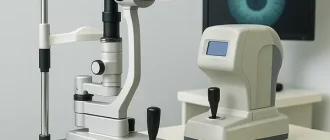Blurred peripheral vision is a symptom, not a disease. This article will help you understand your peripheral vision problem.
The function of the retina can affect individuals’s peripheral vision. Blurred peripheral vision can be triggered by conditions which are not severe such as asthenopia, however severe conditions could likewise be perpetrators. It is advisable for you to visit your doctor whenever you experience blurry vision to prevent additional complications such as loss of vision.
What Does Blurry Peripheral Vision Warn About?
Loss of visual fields is not a disease, but a symptom. If visual field loss has occurred, the causes may be as follows:
- Ophthalmic diseases.
- Volumetric processes in the central nervous system
- Inflammatory diseases of the brain
- Craniocerebral trauma
Only some of the problems are directly related to eye disease. In this article we will discuss the common causes of disorders, but in each case the reasons are subtle and specific – because it is about the peculiarities of the eye nerves and the brain of a particular person. Visual field loss is a symptom of different diseases, so in no case should you engage in self-diagnosis.
What Does the Blurry Peripheral Vision Tell You About
If parts of the field of vision have fallen out in two eyes, this is called hemianopsia. As a rule, hemianopsia affects both eyes, although in rare cases it only appears in one eye. If the visual fields are only in one eye, it may be a signal of damage to the optic nerve or retina. If both eyes are affected, the causes are different:
Comprehensive vision diagnosis Loss of the right visual fields indicates damage to the left visual pathway. Loss of the left visual fields indicates damage to the right visual tract.
- Homonymous hemianopsia. In this case the area at the temple of one eye and the bridge of the nose of the other eye is affected at the same time. Half or part of the vision in each eye may fall out. Loss of the right visual fields indicates damage to the left visual pathway. Loss of the left visual fields indicates damage to the right visual tract.
- Heteronymous hemianopsia. In this disorder, the visual fields on both eyes fall out symmetrically. Temporal or nasal fields may fall out.
This partial loss of the visual field indicates abnormalities in the brain. It can be tumors, the effects of a stroke and other diseases affecting the optic tract and chiasma, the place where the optic nerve fibers intersect in the brain.
Blurry Peripheral Vision and Blind Spots
Blind spots are called scotomas. In the scotoma area, vision may disappear altogether or be blurred. If the person is able to sense that there is a blind spot in his or her eye, it is a positive scotoma, which may be caused by damage to the optic nerve. If the patient does not realize that his field of vision is imperfect, the scotoma is called negative and is diagnosed. Often the cause is a malfunction of the brain structures.
It is also possible to understand the cause of the blind spot by its shape and location:
- If the scotoma appeared directly in or near the visual center, the cause may be a disease of the macula or optic nerve.
- If the scotoma surrounds the central part of the visual field in a ring, it may indicate retinal pigmentary dystrophy.
- If the blind spot is located at the edges of the visual field, there may be a problem with the vasculature.
- More often, scotomas indicate damage to the eye rather than the brain.
Causes and Treatment for Blurry Peripheral Vision
Blurred peripheral vision is when the outer edges of your visual field become unclear or blurry. This condition can happen for different reasons and it can be troubling because it impairs our ability to see objects or movements happening on the sides of what we’re looking at.

In order to find the right treatment, it is essential to identify the reasons behind blurry peripheral vision. Below are the common causes of this issue and their respective treatments:
- Refractive Errors:
- Blurred peripheral vision can occur due to myopia, which is nearsightedness, or hyperopia, which is farsightedness.
- Treatment: Corrective measures such as glasses, contact lenses, or refractive surgery are often recommended to address these issues.
- Eye Conditions:
- Glaucoma is a collection of eye conditions that can result in harm to the optic nerve and, consequently, potential loss of peripheral vision.
- Medical professionals may recommend different treatments such as medication, eye drops, laser surgery, or traditional surgery depending on the type and severity of glaucoma.
- Retinal Disorders:
- Conditions like retinal detachment, retinitis pigmentosa, or macular degeneration can affect peripheral vision.
- Treatment: These conditions often require prompt medical attention and treatment options may include surgery, medication, or low-vision aids.
- Migraines:
- Visual disturbances and blurry peripheral vision are common symptoms experienced during a migraine episode.
- Treatment: Managing migraines typically involves identifying triggers, avoiding them, and taking prescribed medications as directed by a healthcare professional.
- Medications:
- Certain medications, such as antihistamines or antidepressants, can cause blurry peripheral vision as a side effect.
- Treatment: In such cases, consulting a healthcare provider to discuss alternative medications or adjusting the dosage may be recommended.
- Diabetes:
- Diabetic retinopathy, a consequence of uncontrolled diabetes, can lead to a range of eye problems, including peripheral vision blur.
- Treatment: Managing blood sugar levels, regular eye examinations, and treatments like laser therapy may be advised to prevent further vision loss.
- Head Trauma:
- Blurry peripheral vision can be a result of head injuries, concussions, or trauma to the optic nerve.
- Treatment: Seeking immediate medical attention is crucial after a head injury, and treatment may involve rehabilitation, medications, or surgery, depending on the extent of damage.
- Neurological Disorders:
- Conditions like multiple sclerosis (MS) or strokes can affect the optic nerve or brain, leading to blurred peripheral vision.
- Treatment: Treatment plans for neurological disorders are typically personalized and may involve medications, physical therapy, or other interventions as recommended by a healthcare professional.
If you experience blurry peripheral vision, it is essential to consult with an eye care professional or a healthcare provider to determine the underlying cause and receive appropriate treatment. Timely intervention can help preserve and protect your vision, improving your overall quality of life.





